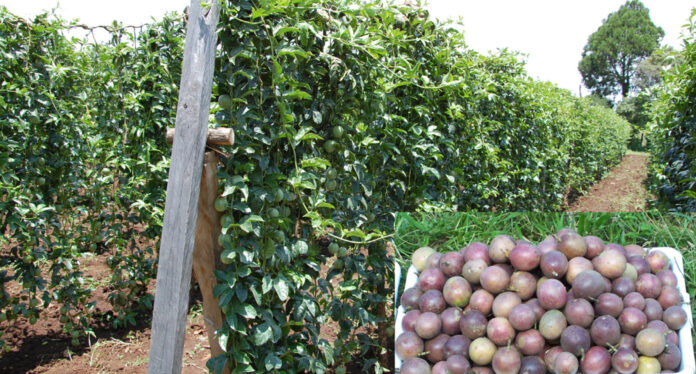Kenya is a large supplier of fresh purple passion fruits to the European market followed by Brazil, Columbia, Nigeria, Zambia and Zimbabwe of which the United Kingdom is the largest importer. Other importers include Holland, France, United Arab Emirates, Germany and Belgium.
The most important passion fruit variety in Kenya is the Purple Passion fruit (passifloraedullis). Fruits have deep purple skin color at maturity. The Yellow passion, Sweet passion, Banana passion and Giant passion are grown in Kenya.
Passion fruit farming in Kenya: The varieties grown locally
| Purple passion fruit
Yellow passion fruit Sweet passion fruit |
Giant passion fruit
Banana passion fruit |
Purple passion fruit
It is the most important in the fruit juice industry and to a certain extent in fresh exports. It grows well in cooler temperatures at an elevation of between 1200m-1800m east of the rift and up to 2000m west of the rift. The fruit is round or oval, 4-6 cm diameter and changes its color from green to purple when ripe. The flavor is outstanding both fresh and canned or frozen. Ripe fruit drop from the vine.
Yellow passion
It is much more vigorous and better adopted to tropical lowlands than purple passion fruit. The pulp is very aromatic but rather acidic. The average fruit is slightly larger than that of the purple and turns from green to yellow on maturity. Ripe fruits drop from vines. The variety is mainly used as rootstock for grafting purple variety, due to its resistance to soil borne pathogens.
Sweet passion fruit or sweet granadilla
It prefers cooler conditions for optimum growth and elevation of about 1500m. The fruit is of excellent flavor and turns from blue to orange-brown at the time of ripening. The whitish, aromatic pulp is enclosed in a hard shell, which can stand transportation without damage.
Giant passion fruit or Giant granadilla
It requires a tropical climate and grows best from sea level up to 1700m. it grows to a length of 30m and fruits turn from green to yellow when mature. Pulp and flesh are eaten fresh and fruit’s appearance resembles a vegetable marrow.
Banana passion fruit
Grows at higher elevations, colder conditions, and altitudes of above 1,500m above sea level. It also has an edible pulp.
Ecological requirements for passion fruit farming in Kenya
Agro-ecological zones: Purple passion fruit does well in the Upper Midland to Upper Highland zones. Yellow Passion Fruit does well in the Lower Midland and Lowland zones.
Altitude: The most suitable altitude for Passion Fruit production ranges from 1200m to 1800m east of the rift and up to 2000m west of the rift.
Temperature: Optimum temperatures for the production of purple and yellow passion fruit are between 18°C to 25°C and 25°C to 30°C respectively.
Rainfall: A well-distributed rainfall of 900 mm to 2,000 mm per year is suitable for passion fruit production. Excess rainfall causes poor fruit set and encourages diseases.
Soils: Passion fruit plants will grow on a variety of soils, which should be reasonably deep and fertile. A soil pH range of 6.0 to 6.5 is best. In high rainfall areas, the soils should be well drained, as plants will not withstand water logging or flooding for any considerable period.
Suitable growing areas: Purple passion Fruit can be grown in Thika, Kisii, Nyeri, Kiambu, Nakuru, Kakamega, Kitale, Murang’a, Embu, Vihiga, Nyamira and Meru, Trans-Nzoia and Uasin-Gishu.
Land Preparation: Deep ploughing is encouraged to open up the soil for aeration and good water infiltration. Strict crop rotation should be practiced to avoid build up of soil borne diseases.
Spacing: The recommended spacing is 2 m between rows and 3 m within rows.
Planting: It is highly recommended to grow purple Passion Fruit grafted on Yellow Passion rootstocks. Propagation is by seed, stem cutting, or grafted propagules. Planting holes of 45 cm × 45 cm × 45 cm should be dug well in advance. Transplanting of grafted propagules is done at the beginning of the rainy season preferably early in the morning or late in the afternoon unless irrigation is available. Ensure that the roots are not flooded and prune long roots back. In the drier areas watering, mulching, and in some cases, shading of young plants is required immediately after transplanting.
Planting materials: Clean, virus-free propagules are transplanted when about 20 cm high.
Fertilizer Application: At planting, add 175 g of Triple Super Phsphate (TSP) and one ‘debe’ (about 20 kgs) of farm yard manure to each hole and mix well. To obtain high yields, regular fertilization is necessary. Apply 300 g of calcium ammonium nitrate (CAN) per plant/year distributed in two applications of 150 g each rainy season. Spraying with foliar feed and trace elements every three months is also recommended.
Trellising: Passion fruit is trained on a trellis constructed from wire and posts. The posts should be270 cm long and 15 cm in diameter. These are placed in 60 cm deep holes spaced 6 m apart in rows, midway between the plants. All end posts must be supported by an anchor. An 8 to 10 gauge galvanized wire is fixed tightly to the top of each post in the row.
Soon after planting two healthy shoots above the graft union are trained up sisal strings, by twining them regularly, until they reach the wire at the top. All other shoots below the wire are removed regularly.
After the trained shoots have reached the wire, the two trained shoots are wound carefully around the wire in opposite directions. While the shoots are growing along the wire, the secondary lateral shoots, which bear fruit, are left to hang down.
Pruning: Old shoots, which are unproductive and all dead wood must be removed as close to the main vine as possible to encourage the growth of new laterals. Secondary shoots reaching the ground level have to be cut off about 15 cm above the ground. Vines should grow vertically to avoid a thicket of shoots. Entangling tendrils should be removed regularly to allow light penetration and aeration and reduce pest and disease infestation.
Intercropping: During orchard establishment, intercropping with short-term annuals is possible. Suitable vegetable crops include kale and cabbage, but not beans as they harbor nematodes. Intercropping also prevents soil erosion but the application rates of fertilizer have to be increased.
Irrigation: During the dry season and in dry areas, the crop has to be irrigated for maximum yield and high quality fruits.
5 organic farming methods that will boost amount of produce in your farm
Maturity/Harvesting: Harvesting of Purple Passion Fruits starts in the eighth to twelfth month after transplanting. For the fresh market, fruits should be picked carefully when they change color from green to purple, and when the calyx has dried up, leaving a short stalk attached. For processing, the fruits should preferably be allowed to drop onto clean mulch. They should not be plucked from the plant. Normally fruits, which have dropped, are collected once or twice a week. During the rainy season they should be picked up every other day and kept in a cool place.
Yields: Yields of 15 to 20t/ ha (6-8t/ac) are attainable.
Field Handling: After harvesting, fruit should be placed in clean plastic or wooden containers and handled carefully to avoid bruising.
Collection Shed: Location of the shed should be accessible to both the farmers and marketers. The design of the shed should have a level of flexibility. Floor should have well designed layout that allows efficient interaction of facilities or activities. This reduces the floor area requirement as well as time and labor costs. It also allows easy cleaning, accommodates product type, plant equipment and product holding activities.
Personal hygiene is important and hence facilities such as toilets and clean water should be at close proximity. All workers should maintain high standards of personal hygiene. Activities such as smoking, eating or chewing should not be allowed in the vicinity.
Clean running water source should be availed and appropriately marked and placed to facilitate hygiene in the premises. It is vital to test water for microbial and bacterial contents regularly and records for chemical treatments safely kept. Disposal systems of any waste including rejects should be environmentally acceptable.
Loading and dispatch areas should be very clean and firm enough to facilitate easy accessibility of any vehicle or operations while dispatching the produce.
Quality control facilities, procedure, standards and records should be availed per produce type to enhance quality. These facilities include waste buckets, decomposition pit, quality assurance rulers, coolants, tables, etc. a charcoal cooler should be provided in the storage room before dispatch.
Sorting: All field debris, diseased, damaged, immature, and over-mature fruits should be removed.
Cleaning: Use a clean damp cloth to wipe off any dirt on the fruits, taking care not to damage the skin by rubbing.
Grading: Fruits of good quality are graded according to size, as small, medium and large.
Pre-cooling: Passion fruit should be cooled immediately after harvest to 5°C to 7°C. forced air-cooling is recommended.
Packing: Packing is done in single or double layer fibre-board cartons or trays, weighing between 2 and 5 kg with an average of 46 to 48 fruits per box.
Storage: Fresh produce should not be stored for more than 24 hours. However, a storage temperature of 5 to 7°C and a relative humidity of 85% to 90% should maintain the fruit in good condition for three to five weeks.
Transportation: Boxes must be packed firmly to prevent fruit friction and damage during transportation. The truck should be covered and well ventilated.









